
Feng shui (pronounced “fung shway”) may seem like a dated principal, but if you’re feeling not quite right in your space, it may be time for a little reorganizing. Feng shui is a system to help organize and arrange the items around you to account for the flow of energy. This centuries-old practice is lauded for bringing in good chi, like improved health and good fortune, while keeping out bad chi, like bad luck or sadness.
Incorporating feng shui in your bedroom could lead to improved sleep and more relaxation—something we could all use a little extra of. But feng shui is more than just shifting some furniture around. By incorporating certain elements into your home, feng shui can unlock harmony and comfort—and it’s much easier than you might think. Use our beginner’s guide below to get started.
Quick Feng Shui Tips for Your Bedroom
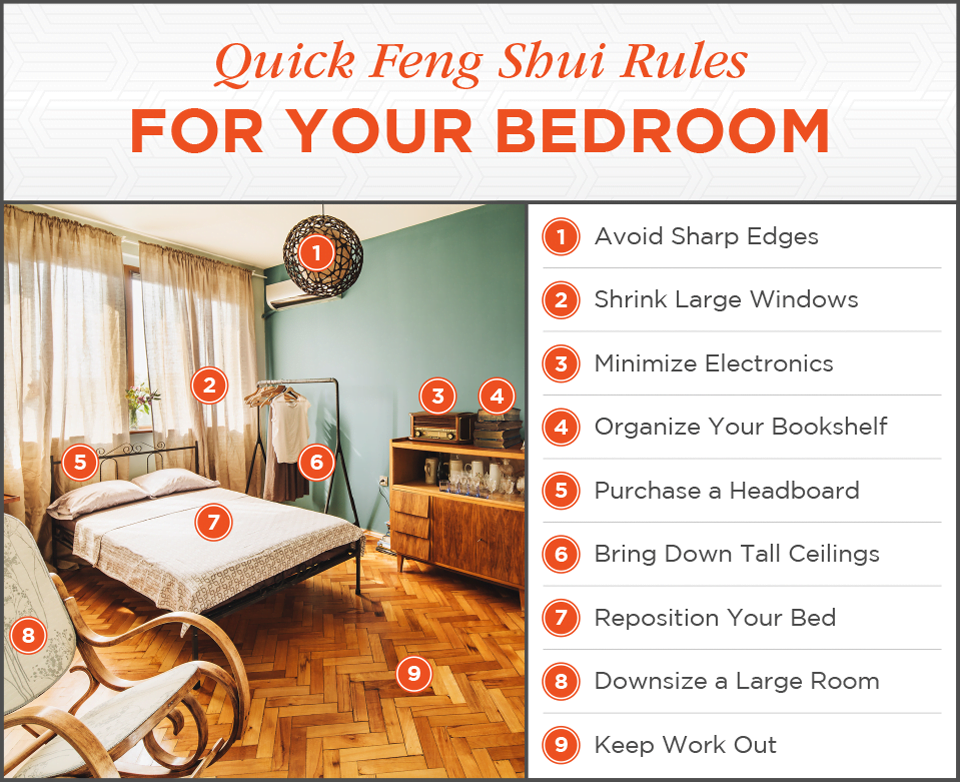
1) Avoid Sharp Edges
A jagged, pointy edge doesn’t feel inviting—so why would you incorporate it into your bedroom? Some items like dressers and nightstands you may not be able to help, but you can soften your space by adding more natural decor like plants, lamps, sculptures and other smooth edges.
2) Shrink Large Windows
A huge view from your bedroom may seem like a desirable trait, but too large and you can be left feeling uncomfortable and “spied” upon. To easily reduce a window, add darker drapes or curtains along both sides of the window to create a cozier feel.
3) Minimize Electronics
Even when turned off, televisions and other appliances give off electromagnetic energy while you sleep. Keep smaller items, like an alarm clock or your smartphone, at least three feet from where you rest your head.
4) Organize Your Bookshelf
You wouldn’t think a simple bookshelf could impact your mood, but proper organization can make or break a room’s feng shui. Organize your books based on color and weight—placing the heavier books at the bottom of the book case. Also, don’t push your books all the way to the back, align them right on the edge of the shelf to create an even line.
5) Purchase a Headboard
Similar to the tip above, we like to feel comfortable and protected in our bedroom. Adding a sturdy headboard to your bed creates a more secure feeling over a bare wall.
6) Bring Down Tall Ceilings
Cathedral ceilings are impressive to look at, but actually make us feel vulnerable and small in a room. Seven to nine feet tall is ideal, but if you want to bring down the height more, there are a few tactics like painting the ceiling a darker color or adding visual interest to the lower half of the room with pillows, area rugs or vases.
7) Reposition Your Bed
In feng shui, bed placement plays a huge role. Ideally, your bed should be positioned against the opposite wall from your bedroom door. If that isn’t feasible, position it as far away from the door as possible—you want to avoid having your headboard on the same wall as the door. This will create a feeling of security and allow you to relax every night.
8) Downsize a Large Room
It may seem counter productive—wouldn’t an open space put you more at ease? But too large of a bedroom can actually create a feeling of insecurity, since we like our bedrooms to feel intimate and private. Since you can’t go knocking down walls, consider adding other small furniture like a vanity or seating area. Painting your bedroom in warmer tones also helps bring the room together and feel cozier.
9) Keep Work Out
If you have a larger bedroom, resist the urge to convert some of the space into a small home office. Work associated items like laptops and phones create a distracting environment. Even work out items, like treadmills or weights, can keep you from feeling at ease.
Feng Shui Bedroom Art Ideas
Sometimes, rules are meant to be broken, and this applies to feng shui too. There are many routes you can take when decorating your bedroom and you should always opt for what fits your personality and style. But, if you’re looking for some guidance using feng shui, here are some general rules:

1) Choose Relaxing Artwork
Busy paintings that don’t give off relaxing vibes should be kept out of the bedroom. Another consideration is to keep any large mirrors as far away from the bed as possible, as the reflective images and be distracting while you’re trying to sleep.
2) Stay Positive
Decorate with artwork that displays positively imagery or connotations, like a fun, upbeat saying or a photo of someone smiling. Avoid overly dramatic prints or things that give you a strong emotional response.
3) Don’t Hang Above the Bed
If you don’t have a headboard (which you may want to consider—see our quick tips below), resist the urge to fill that space with artwork, especially heavy sculptures. Art above our heads will make us fear of it falling on us at night. Instead, use the three other walls in your bedroom.
4) Find the Perfect Pair
Images like your wedding photos not only conjure fond memories, but photos of a pair can also bring about feelings of relaxation. Even if you’re not married, decorating with artwork that shows pairs creates a feeling of intimacy.
Creation vs. Destruction Elements
If you’re familiar with feng shui, you may also know of the five core elements that make up the practice. Those elements are:
- Fire
- Earth
- Metal
- Water
- Wood
According to feng shui, you need all five elements in a home, but the challenge is creating a balance so one element doesn’t overtake the group. While each element supports another (for example, wood supports fire), other elements can diminish another (for example, water puts out fire). To quickly understand the creation and destruction cycles, follow this cycle:
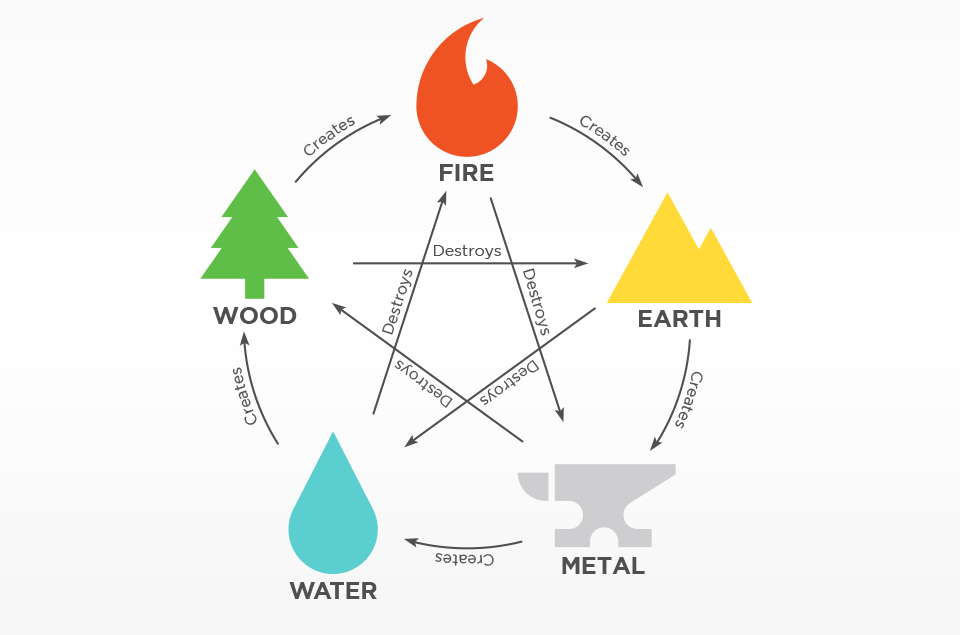
Each element in the cycle has multiple ways to manifest itself in your home. Some examples are:
Fire
- Candles
- Geometric patterns like cones, pyramids and triangles
- Landscape artwork of sunrises or sunsets
Earth
- Textiles like granite, brick or cement
- Decorative rocks and pebbles
- Mountain or desert landscapes
Metal
- Metal materials like bronze, silver, gold or copper
- Oval or circular furniture
- Metal sculptures
Water
- Small water additions like waterfalls or aquariums
- Free-form artwork
- Glass
Wood
- Wooden floors and furniture
- Tall, vertical shapes
- Floral artwork
Life Aspiration Areas
The second component to feng shui is balancing your entire home with each element so as you navigate from room to room, you’re achieving your best possible self. These are called Life Aspiration Areas, which include:
- Career
- Knowledge
- Family
- Wealth & Prosperity
- Fame
- Love & Partnership
- Creation
- Synchronicity
- Health
The above nine Life Aspiration Areas are reinforced based on the presence or absence of the five elements in your home. Here’s how each work together:
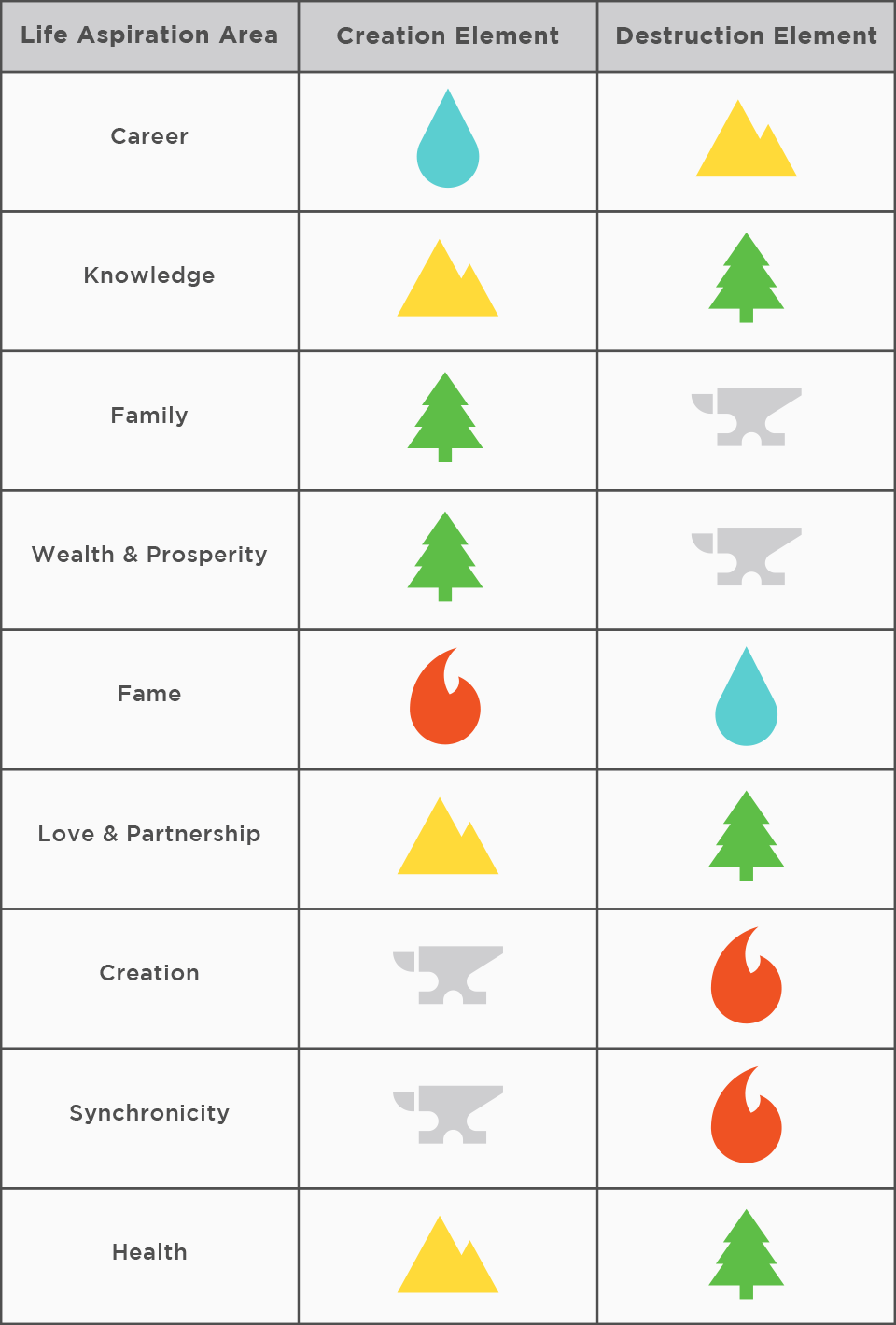
Career
Career doesn’t only apply to your job, but also your overall direction in life. Activating this in your home can give you a space to make goals or re-energize your current work.
Direction: North
Main element: Water
Destructive element: Earth
Knowledge
Meant to encourage self-nurture, the knowledge area of your home can help with studying for school or learning something new.
Direction: Northeast
Main element: Earth
Destructive element: Wood
Family
This can refer not only to your immediate family, but also extended family members and friends. Family can be reinvigorated by displaying family photos or indoor plants to reinforce a feeling of togetherness.
Direction: East
Main element: Wood
Destructive element: Metal
Wealth & Prosperity
You probably won’t become a millionaire overnight, but encouraging this area in your home can improve your work.
Direction: Southeast
Main element: Wood
Destructive element: Metal
Fame
Fame doesn’t mean you’ll automatically catapult to celebrity. Rather, incorporating fame into your home means acknowledgment, recognition and promotion.
Direction: South
Main element: Fire
Destructive element: Water
Love & Partnership
This can support a nurturing relationship you already have or help in attracting a partner. Consider subliminal messages, like artwork of items in pairs.
Direction: Southwest
Main element: Earth
Destructive element: Wood
Creation
Creation focuses on generating something new that didn’t previously exist. This can be helpful for artists and creative people, as well as people hoping to start a family.
Direction: West
Main element: Metal
Destructive element: Fire
Synchronicity
This area may seem a little vague, but it can relate to finding a connection with people or a place. If you recently moved, enhancing synchronicity can help with meeting new friends.
Direction: Northwest
Main element: Metal
Destructive element: Fire
Health
The Health Area will be the center of your home and bring you the most peace. Try to keep this part of the home clutter free, especially if it falls in a busy entryway or room.
Direction: Center
Main element: Earth
Destructive element: Wood
Layout Your Home for Feng Shui
So how do you know what element belongs in your master bedroom? It’s hard to know without mapping out your home based on the Life Aspiration Areas, but thankfully it’s not that difficult to do. You can easily accomplish this in your home with some simple store bought tools.
What you’ll need:
- A compass
- Graphic paper
- Tracing paper
- A ruler
- A pencil
Step 1: Use an existing floor plan or measure the outside and inside rooms of your home.
Step 2: Translate the measurements to scale on graph paper (ex: 1 foot = 1 square).
Step 3: Find the center point of your home by folding the outline in half vertically and horizontally. Draw an “x” in the center of the fold.
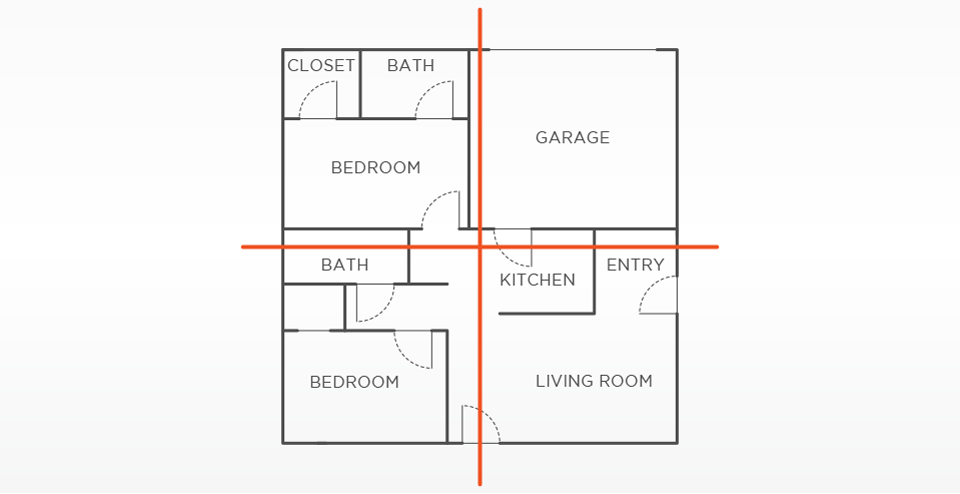
Step 3a: If you’re home isn’t a perfect square or rectangle, you’ll need to fill in missing space. Do this by folding the sheet down the middle vertically. If there are rooms that make up more than 50 percent of the wall it’s on, draw a dotted line extending from its corner to make up for the missing space.
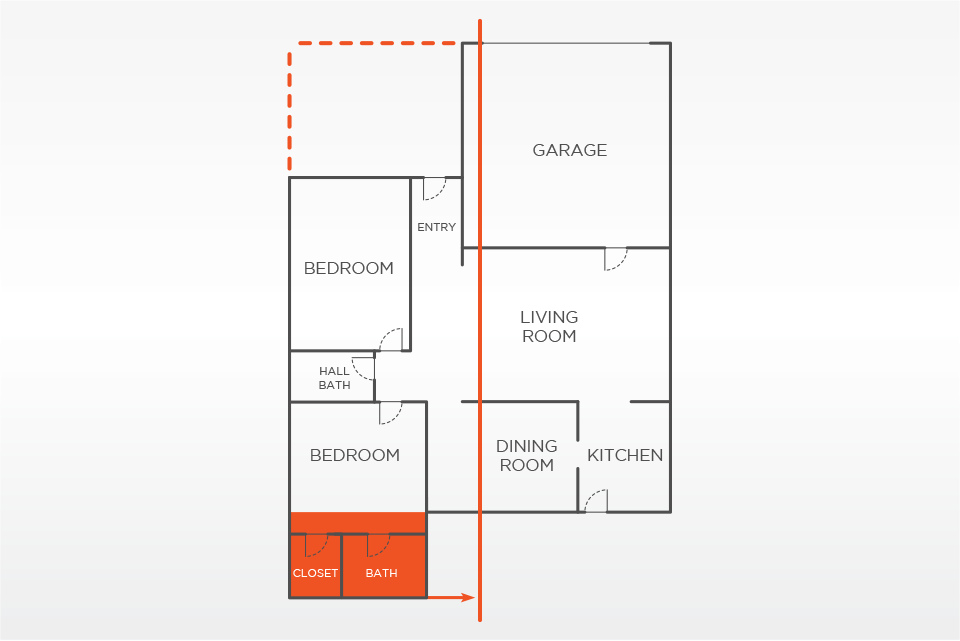
Step 4: Take your compass and walk to the actual center of your home where you drew the “x”.
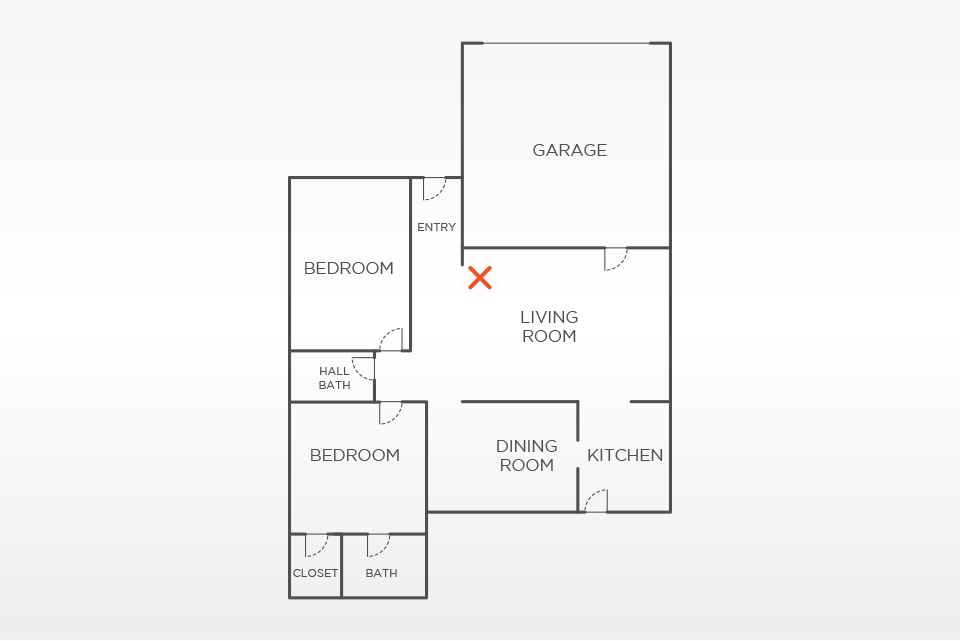
Step 5: Place your floorplan on the “x” in the room, then place the compass on top of the floorplan.
Step 6: Start marking your Life Aspiration Areas, starting at 0° and labeling as follows:
0° – North
45° – Northeast
90° – East
135° – Southeast
180° – South
225° – Southwest
270° – West
315° – Northwest
Step 7: Once done, use a ruler to draw dotted lines from the center out to each direction on the floor plan.
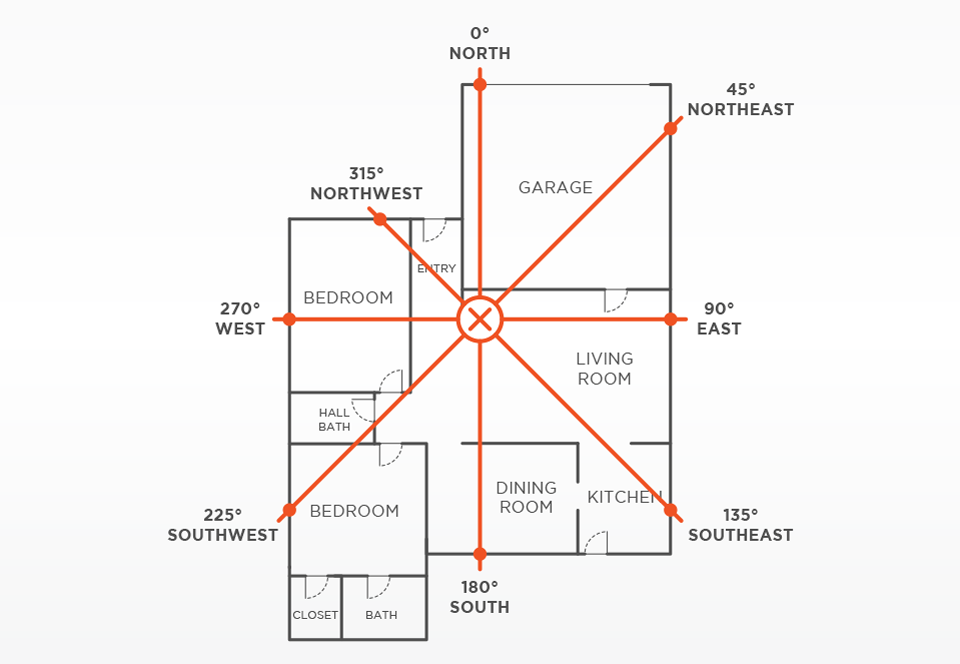
Step 8: Label each direction with their corresponding Life Aspiration Area.
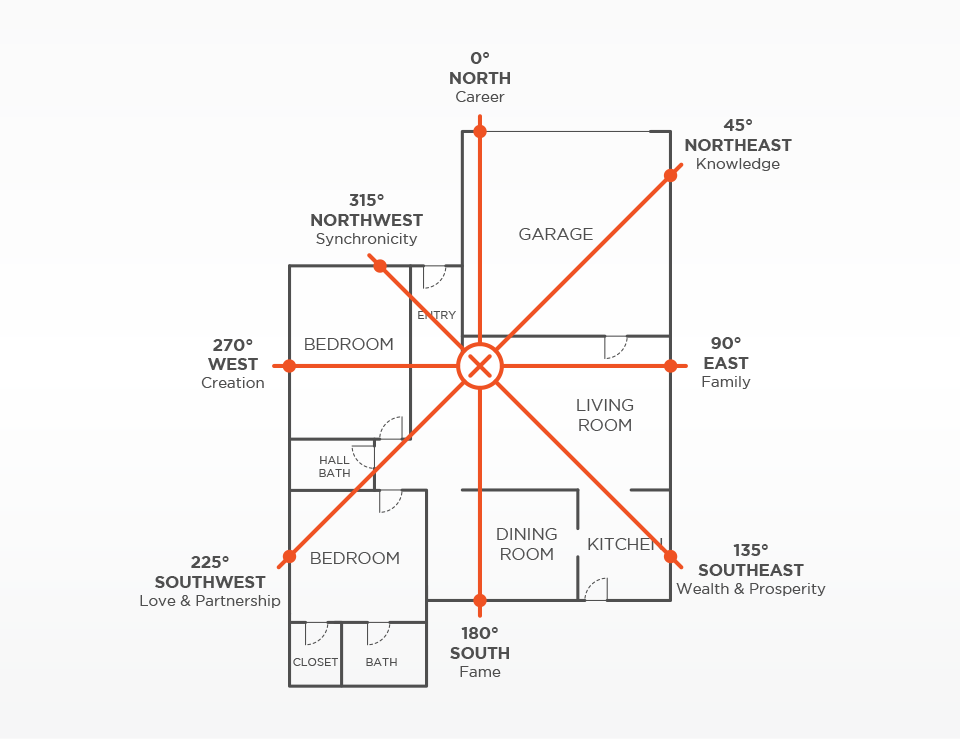
Feng Shui Bedroom Colors
Before you get to moving that heavy heirloom armoire, consider the colors in your master bedroom and how it impacts your mood. There’s no wrong way to go about decorating your bedroom, and ultimately you should paint your room however feels right to you, but feng shui can help as a guide for applying color.
Each element in feng shui comes with matching colors. It’s important to note though that simply painting a room a certain color won’t reinforce the Life Aspiration Areas. It’s much more effective to have physical manifestations of the element (for example, a small waterfall decoration over painting your room blue).
If you are looking for the colors to support or suppress a different element, use the following:
- Fire colors: red and purple
- Earth colors: yellow and orange
- Metal colors: white and silver
- Water colors: blue and black
- Wood colors: green and brown
Conclusion
With this guide in hand, you’re ready to not only recreate your bedroom, but map out your new feng shui house. Even though feng shui comes with a lot of rules, that doesn’t mean you can’t get creative. Make your bedroom feel more like your own with personalized home decor like fleece blankets, throw pillows and canvas prints.
Source: McCandles, C. (2011). Feng Shui That Makes Sense. Minneapolis, MN: Two Harbors Press.





